State of the economy: February 2020
Report produced tri-annually by the Chief Economic Adviser to provide a picture of the Scottish economy in an international context.
Scottish Economy Update
Gross Domestic Product
Economic growth in Scotland slowed in 2019 with growth of 0.4% in the first three quarters of the year compared to 1.4% growth over the same period in 2018.[1]
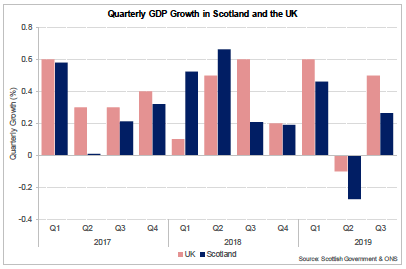
The pattern of growth was also relatively volatile with economic activity, particularly with regards to stockpiling in the manufacturing sector, influenced by the Brexit deadlines in March and October.
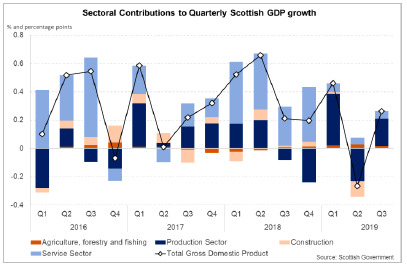
Following the Brexit deadline extension in March last year, output in Scotland, and the UK as a whole contracted in the second quarter of the year as firms unwound safety stocks that had been accumulated in the first quarter. However, economic activity rebounded in the third quarter of the year, with output in Scotland growing 0.3% over the quarter, slightly below UK growth of 0.5%.
Services sector growth remained stable in 2019, though notably slower than in 2018. In Q3 2019, Services output continued to grow at 0.1%, with the strongest contributions over the quarter from Business Services and Finance, offsetting falls in output from Distribution, Hotels and Catering and Transport, Storage and Communications.
Production sector output picked up in the third quarter, growing 1.1%, driven mostly by an increase in electricity and gas output, in part from an increase in wind and hydro-electricity generation. Elsewhere in the Production sector, Manufacturing output contracted for the second consecutive quarter (-0.3%), albeit at a slower pace, as firms continued to navigate their way between the March and October Brexit deadlines. Latest UK GDP and business survey data[2] indicate that there was further volatility from stockpiling and unwinding in Q4 2019, but not to the same extent as at the start of the year. Scottish GDP data for Q4 2019 will be available in March 2020.
Construction sector output growth was flat in the third quarter (0.0%) and fell 1.1% over the past year compared to a 1.2% increase in the UK as a whole. Despite some relatively large quarterly fluctuations in the data, the level of construction output in Scotland has generally eased back slightly over the past couple of years, following a period of more robust growth between 2014 and 2017. However, the level of output from the sector remains high by historical standards.
Long run Scotland and UK trends in GDP per capita
The performance of the Scottish economy relative to the rest of the UK is an important issue for the Scottish budget and the wider fiscal framework.
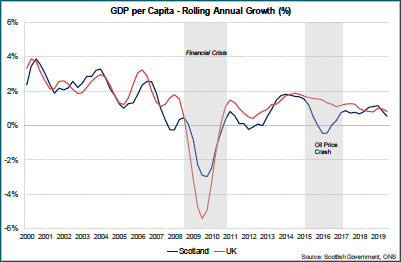
GDP per person is a common measure of the economy that is often used to compare the relative economic performance of countries and regions with each other and is one measurement of a country’s standard of living. The adjacent chart shows that growth in GDP per person in Scotland and the UK as a whole has been similar over the last two decades, with both economies tending to follow similar business cycles and similar average growth rates across periods of time.
There have been two major exceptions to this observation: first during the financial crisis where Scotland had a less severe contraction but slower recovery and second in 2015/16 when the global oil price fell sharply and lead to a contraction in the Scottish production sector and domestic supply chains feeding into the North Sea. Since 2017 growth in the Scottish economy has improved and is again broadly back in line with the UK.
In conclusion, Scotland and the UK follow similar business cycles over the long run but there can be economic “shocks” that affect the UK economy to a greater / lesser degree than the Scottish economy and vice versa. Taking a longer term view on this issue improves our understanding of the potential for asymmetric risks in the two economies and could help to inform decisions on future fiscal arrangements.
Business investment continued to weaken in 2019 amid ongoing uncertainty surrounding Brexit and the underlying risk of a no-deal Brexit.
Business Investment
In Q3 2019, business investment contracted by 2.4% over the quarter – its fourth consecutive quarterly fall - and fell 13.5% over the year.[3]
Business surveys also continued to report that business investment remained weak in the final quarter of 2019. The Scottish Chambers of Commerce Quarterly Economic Indicator (Q4 2019)[4] signalled that investment levels remained subdued across most sectors.
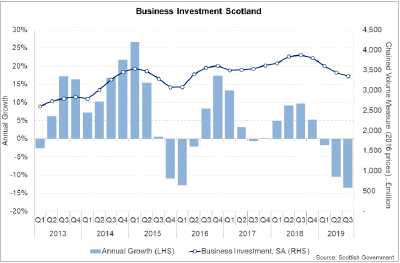
Looking ahead, while the immediate risk of no-deal Brexit has been removed, the level of uncertainty surrounding trade negotiations and the future relationship between the UK and EU risks further weighing on investment growth in 2020. The Scottish Business Monitor for Q4 2019[5] reported that firms, on balance, expect capital investment to remain unchanged over the next six months with further evidence of new business projects being postponed. At a UK level, the Bank of England Agent’s survey showed that investment and hiring intentions remained negative with some companies reporting that they wanted to see how trade negotiations with the EU progressed before reassessing their plans.[6]
Retail Sales
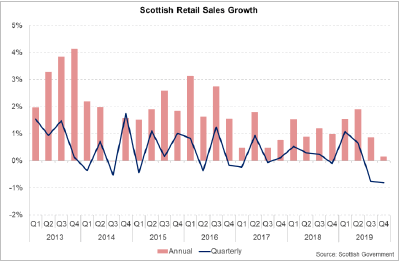
Retail sales growth has remained relatively subdued, though resilient, over the past 3-years and into the first half of 2019, however weakened notably in the second half of the year.
Retail sales contracted in both Scotland (-0.8%) and GB as a whole (-1.0%) in the final quarter of 2019.[7] This was the second consecutive quarter of contraction in Scotland, and reflected a general slowing in the pace of GB growth during the year.
Across 2019 as a whole, retail sales in Scotland grew 1.1%, broadly in line with growth in 2017 and 2018 (0.9% and 1.2% respectively). However, growth has remained more subdued than in GB as a whole, which grew 3.4% in 2019.
Trading conditions have continued to be challenging for the retail sector in 2019, with retail footfall growth in Scottish town and city centre locations remaining weak. Alongside this, consumer sentiment in Scotland has weakened in 2019, and business optimism in the retail and wholesale sector has remained subdued indicating challenges on both the demand and supply sides.
Looking ahead, weak consumer sentiment remains a risk for the sector and the potential impact it may have on the purchase of discretionary items such as electrical goods and cars, while core products would be expected to be less impacted. Retail firms may also need to consider and review any potential disruption to supply chains and operations over the year as details from the Brexit negotiations emerge.
Identifying clusters in the Scottish Economy
In December 2019, the Scottish Government published new analysis, ‘Identifying Clusters of Industries’ to show an alternative way of grouping industries in the Scottish economy[8].
Standard Industry Classification
Normally when calculating GDP, industries are grouped together according to an internationally agreed system, the Standard Industrial Classification (SIC)[9]. This allows for meaningful comparisons of GDP across countries. SIC groups together parts of the economy that make the same general types of goods or services. However, these industries aren’t necessarily buying the same things, feeding into the same industries or affected by the same factors. As a result the SIC system does not always capture cross-cutting trends in GDP.
Network Analysis
By undertaking network analysis to group Scottish industries in a different way, allows for alternative insights into the underlying trends/drivers of Scottish GDP.
Network analysis takes information on the Scottish economy and uses it to create a number of industry groups which have more in common with each other than they do with other industries. [10] Industry groups were formed based on how dependent each industry is on the output of the other industry. This resulted in eight large and ten small industry groups (capturing c. 83% of the Scottish economy). The remaining 17% of industries were ‘unclustered’, e.g. too distinct to be grouped with other industries.
Results
Comparing the contributions to Scottish GDP over the year to 2019 Q3 using the SIC system (left chart) and the industry groups created by the network analysis (right chart) creates a different narrative around which sectors have been driving growth over the past year.

Under the SIC system, it appears that many sectors of the economy are contributing towards growth. However, the network analysis approach indicates that over the past year, there have been a small group of sectors really driving Scottish GDP growth.
For example, Finance & Estate Agents, which make up 4% of the Scottish economy, appear in particular to have been a key contributor to economic growth over the past year and consist of estate agents (includes real estate and rent collecting agencies), banks and building societies. The Energy Intensive group, which make up 5% of the economy and is the second biggest contributor to growth over the past year, consists of 8 sub-industries, the largest ones being electricity, passenger land transport and gas.
The international trade environment weakened in 2019 amid ongoing trade tensions and a softening in global growth and trade.Exports
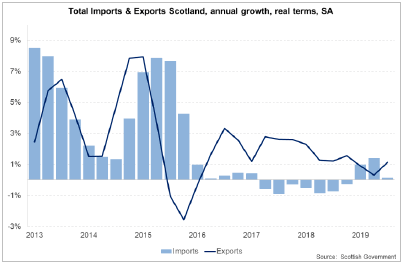
Alongside this, Brexit uncertainty continued to impact on the exchange rate, with sterling weakening to its lowest levels since 2016 (c. 1.20 $/£) over the first half of the year, before strengthening back to c. 1.30 $/£ later in 2019 and into the start of 2020.
In Q3 2019, total Scottish exports grew by 1.1% annually, while total imports grew by 0.1%, resulting in an improvement in Scotland net trade balance, having weakened earlier in the year.[11]
In terms of Scotland’s international manufactured exports specifically, growth has been relatively volatile over the past year, and may reflect the general fluctuations in manufacturing activity in relation to stockpiling over the year.
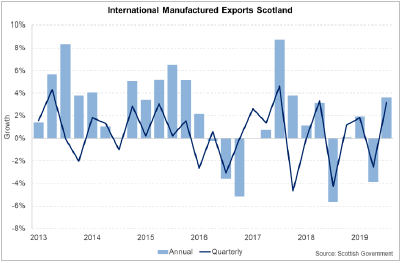
International manufacturing exports grew by 3.2% in Q3 2019 and 3.6% over the year, following a contraction in the second quarter.[12] The largest contributor to the increase in exports over the year was Food and Drink (8.4%), while Engineering, Machinery and Metals also increased over the year (5.5%). This offset a fall in Refined petroleum, chemical and pharmaceutical product exports (-8.4) and other manufactured products (-7.0%).
Looking ahead, there are signals that the global economic environment may be stabilising at the turn of the year, with signs of stronger growth and a potential easing in trade tensions. For example, the Global Composite Purchasing Managers’ Index (PMI)[13] signalled a strengthening in both services and manufacturing sector output in January 2020, while the Global Manufacturing PMI[14] indicated that manufactured exports continued to fall albeit to a lesser extent than in recent months. However, a key element of uncertainty for Scotland’s international trade outlook remains the nature of any trade agreement reached between the UK and EU at the end of 2021.
Labour Market
Alongside weaker output growth in the economy, labour market indicators for Scotland have also softened over the past year. However, the labour market continues to perform strongly by historical standards and overall remains tight.
Scotland’s unemployment rate fell over the latest quarter to 3.8% in September – November 2019 and is in line with the rate for the UK as a whole.[15] However, unemployment in Scotland has risen from its record low of 3.2% earlier in the year and over the past year the number of people unemployed has increased by 4,000 to 105,000.
| Scotland Labour Market Statistics (Sep to Nov 2019) | |||
|---|---|---|---|
| Rates | Latest (%) | Quarterly Change (% p.t.) | Annual Change (% p.t.) |
| Employment* | 74.3 | 0.0 | -1.0 |
| ILO Unemployment** | 3.8 | -0.3 | 0.2 |
| Economic Inactivity* | 22.7 | 0.2 | 0.8 |
| LEVELS (‘000) | Latest | Quarterly Change | Annual Change |
| Employment (16+) | 2,654 | 18 | -17 |
| ILO Unemployment (16+) | 105 | -7 | 4 |
| Economic Inactivity (16-64) | 781 | 8 | 28 |
| *Denominator = Working age population (16-64) | |||
| **Denominator = Total economically active | |||
Alongside this, despite a pick-up in employment in the latest quarter, the employment rate remained at 74.3% and over the past year, the number of people in employment fell by 17,000.
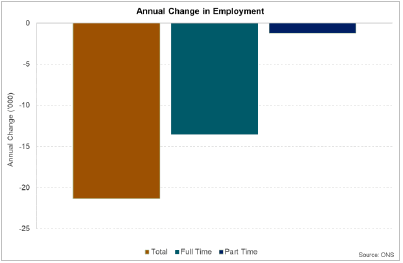
The fall in the number of employees over the past year was predominantly driven by a decrease in full-time workers which fell by 14,000, while part-time workers fell by 1,000.
However, the difference between the falls in both employment and unemployment are reflected in higher inactivity in Scotland, which has risen by 28,000 over the past year to 781,000. This has seen the inactivity rate in Scotland rise to 22.7% and diverge from the UK inactivity rate which fell over the past year to 20.6%.
Softer conditions in the labour market have also been reflected in business surveys, with firms reporting that permanent vacancy growth remained mild at the end of 2019, before picking up slightly at the start of 2020. Demand for temporary staff also increased in January, though at lower rate than at the end of 2019.[16] The more resilient growth of temporary vacancies in 2019 potentially reflects the heightened uncertainty during the year and the response of firms to that. However, ongoing tightness in the labour market remained evident with both permanent and temporary candidate availability falling at an increased rate in January.
Looking ahead, the Scottish Fiscal Commission forecast[17] the Scottish labour market to remain relatively tight, with employment continuing to grow, though at a slower rate than over the past few years.
Earnings
The continued tight labour market conditions were reflected in further earnings growth in 2019.
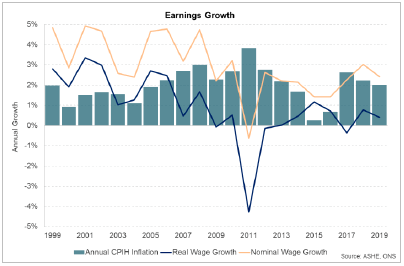
The Annual Survey of Hours and Earnings (ASHE) showed that median full-time weekly earnings in Scotland were £576.70 in 2019 (UK: £584.90) and remain the fourth highest of the twelve UK countries and regions behind London (£736.50), the South East (£613.50) and East (£581.00)[18].
It showed that median full-time weekly earnings grew 2.4% in Scotland in 2019, below the UK rate (2.9%) and had slowed slightly from 3% growth in 2018. While this potentially reflects the wider softening in labour market conditions over the year, the pace of earnings growth remained stronger relative to the pace of annual growth since 2012.
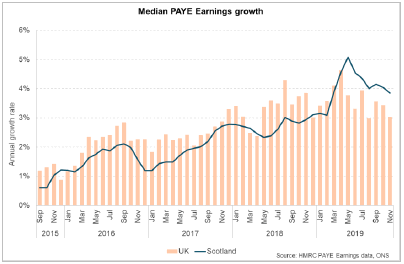
More recent PAYE earnings data shows a slightly different picture with nominal median earnings growth in Scotland strengthening in 2019 compared to recent years. However, the pace of growth did slow in the second half of the year from 5.1% growth in May to 3.9% in November, though remained above UK growth of 3% in November.[19]
Adjusting for inflation, earnings growth in Scotland remains subdued. ASHE data shows that real earnings increased by 0.4% (UK: 0.9%) over the year, down from 0.8% growth in 2018.
Looking ahead, the Scottish Fiscal Commission forecast[20] earnings growth to strengthen to 3% in 2020 (1.1% in real terms), reflecting the ongoing tightness in the labour market. However, in the longer term, the pace of growth is expected to be moderated by the weaknesses in productivity growth and a softening in wider labour market indicators.
Labour Productivity
Productivity (output per hour) growth strengthened slightly in the third quarter of 2019, growing 0.2% over the quarter and 0.8% over the year.[21]
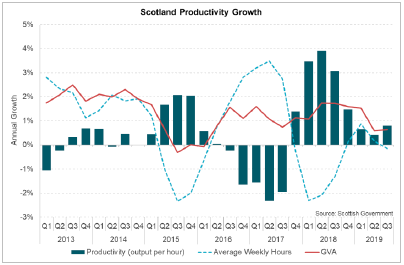
However Labour productivity growth has generally moderated in 2019, reflecting the slower pace of output growth and a pick-up in average weekly hours worked, potentially reflecting the tightness in the labour market.
Considering Scotland’s productivity growth over a longer term and in an international context, average annual productivity growth in Scotland over the past decade (0.9%) has been above the UK (0.4%) and in line with the OECD as a whole, having lagged both in the previous decade. Within a UK context, this has resulted in Scotland closing the productivity gap with the UK as a whole to 1% in 2018, having been 8-10% lower prior to 2008.
| Average annual growth in GDP per hour worked (%) | |||
|---|---|---|---|
| 2000-2008 | 2008-2018 | ||
| Real terms | Scotland | 1.1 | 0.9 |
| UK | 1.7 | 0.4 | |
| EU28 | 1.3 | 1.0 | |
| OECD | 1.6 | 0.9 | |
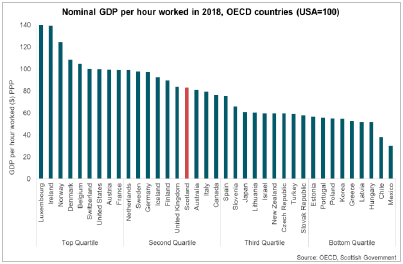
In an international context, in 2018, Scotland ranked 16th (out of 37 countries) amongst the OECD countries, which places Scotland in the lower half of the second quartile, largely unchanged since 2007.
Looking ahead, the Scottish Fiscal Commission forecast[22] weak business investment to weigh on productivity growth in the short term and strengthen over the forecast period while remaining below its average prior to the financial crisis.
Brexit remains a risk to future productivity growth however and the following box considers how the Scottish economy might adjust in the short term during the transition phase and in response to whether a trade agreement is in place at the end of the year. Further analysis at the end of the document sets out the potential longer term sectoral impacts of a free trade agreement with the EU.
EU Exit – Short Run Economic Impacts
All forms of EU exit will impact Scotland’s economy and result in lower household incomes than would otherwise have been the case had Scotland remained in the EU. In the long run, our modelling[23] shows that compared to continued EU membership:
- A Free Trade Agreement of the type the UK Government wants to negotiate could lead to a loss of up to 6.1% of GDP in Scotland by 2030 - equivalent to £1,600 per person.
- No trade agreement by December 2020 (resulting in trading on WTO terms) could lead to a loss of up to 8.5% of GDP in Scotland by 2030 – equivalent to £2,300 per person.
This can be thought of as growth forgone over an extended period rather than a contraction in growth.
How the economy might adjust in the short term:
The first half of 2020
- Uncertainty: Although the immediate disorderly exit risk has been removed, uncertainty over the UK’s future trading arrangements will remain elevated until details of any trade deal emerge.
- Trade: In the transition period, trade will continue without additional frictions.
- Investment: Business surveys have signalled a recent improvement in sentiment so some pick-up in business investment may occur, even if only firms investing in maintenance.
- Household consumption: Consumer sentiment remains weak and ongoing uncertainty means that consumer spending is unlikely to pick up significantly.
- Inventories: Further running down of safety stocks built up in 2019 will unwind and subtract from growth.
- Labour Market: Business surveys have signalled that hiring intentions remain weak.
The second half of 2020
- Uncertainty: As details of any trade deal emerge, uncertainty could reduce further. This could be as late as Quarter 4 and the timing will also be influenced by how other trade relations (UK–EU–US-China) develop.
- Trade: In the transition period, trade will continue without additional frictions.
- Investment: Is likely to remain weak and dependent upon the communication of the details of future trade arrangements and any reduction in uncertainty in the business climate.
- Household consumption: Ongoing uncertainty means that consumption is likely to remain weak.
- Inventories: If there is still no Free Trade Agreement in place towards the end of 2020 then some limited stockpiling may occur (not to the same extent as in 2019 - reflecting how businesses have learned and responded to uncertainty over the course of 2019). This would provide a small temporary boost to economic activity that would subsequently unwind in 2021.
- Labour: Some businesses are also dealing with pressure of lower availability of EU labour in key sectors and this may worsen if the UK adopts tighter migration regimes. For some sectors, if new economic activity is created in the EU rather than in the UK then this could result in jobs foregone in Scotland rather than job losses.
- Speed of adjustment: The shortened transition period (11 months rather than the 2 years originally envisaged) will concentrate the impact rather than allow the economy to gradually adjust to the new relationship. If the transition period is extended or access deals are agreed beyond December 2020, the overall impact could be low growth over a longer period.
Early 2021 – With a Trade Agreement
- Disruption: Although an agreement would represent an ‘orderly’ transition, the minimal time for adjustment to the new agreement will lead to some disruption.
- Trade: Exporters (goods and services) will face increasingly costly non-tariff barriers to trade with the EU and third party countries where existing FTA’s are ‘not rolled over’ from the beginning of 2021 and so trade flows will be reduced.
- Competitiveness: Businesses will experience a financial burden in adjusting to the regulations, customs procedures, tariffs, import and export patterns, processes and prices, skills and labour, and additional administration.
- Labour: Services sectors are particularly likely to be affected by restricted movement of labour.
- Small and Medium-sized Enterprises: For small Scottish service providers who export, the requirement to set up a presence in other EU countries where this does not currently exist may be too costly, and the loss of regulatory alignment or the impact of trade reservations may make it impossible for trade to continue, e.g. some legal services.
- Services: Without agreements on freedom of movement and establishment, Scotland’s service industry would face significant disruption and barriers to trade (around £5 bn of service exports are currently to the EU)
Early 2021 – Without a Trade Agreement
- Disruption: This would represent a ‘disorderly’ scenario and so in the short term there is likely to be disruption to supply chains and restricted market access.
- Trade: If there is no Free Trade Agreement with the EU in place at the end of 2020 and there is no extension to the transition period, then the UK would be expected to revert to trade with the EU on WTO terms. This will disrupt and reduce trade flows.
- Labour: The labour market may soften if external conditions remain challenging and the higher costs and restricted access experienced by some firms as a result of changes in the terms of trade may affect their viability leading to firm closures and associated job losses.
- Sectors: The impact across sectors will vary and there could be significant disruption in sub-sectors dependent on EU trade and rules (see accompanying Box on sectoral impacts on page 19).
- Aggregate economy impact: Growth will remain weak with the potential for negative quarterly growth but it is not anticipated that this scenario will lead to the same deep recessionary risk to the economy nor the same scale of job losses as under the No Deal scenario previously analysed by the Scottish Government in February 2019.
- This is largely because: (i) some of the assumed impacts in the earlier analysis have already taken place and have been weighing on the economy; (ii) the timetable and legislation in place for exit and the fact that it is clear now that the UK will be outside of the customs union has decreased uncertainty; and (iii) the financial and currency markets have priced these changes in to some extent (over the past year we have seen movement in currency and stock markets directly related to trade policy announcements).
- Nevertheless, a complete absence of any trade rules creates significant uncertainty and consequent economic damage.
These short run impacts could be mitigated by policy responses including fiscal stimulus and trade and access agreements. The long term implications are likely to provide a headwind to growth rather than causing a contraction per se, however this is in the context of growth rates that are already low by pre-financial crisis standards.
Business and Consumer Sentiment
The slowing in the economy and labour market over the past year, alongside heightened political and economic uncertainty, has been reflected in business and consumer sentiment.
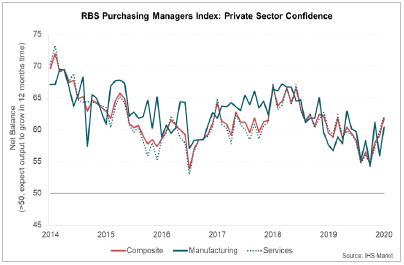
The latest RBS Purchasing Managers Index[24] reported that business activity remained stagnant in the final quarter of 2019, before picking up mildly at the start of 2020. However, at a sector level, the manufacturing sector has continued to report falling activity amid weak external demand and ongoing uncertainty.
Looking ahead, business confidence picked-up broadly in January, however, overall remains subdued by historical standards. Subdued business optimism was captured across most sectors in other recent business surveys[25] and remains a downside risk to future business investment and growth. For example, the Scottish Business Monitor for Q4 2019[26] reported that firms expect capital investment to remain unchanged over the next six months.
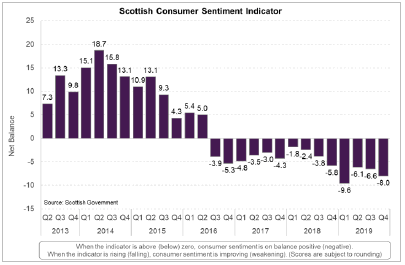
Consumer sentiment[27] followed a similar trend to business confidence in 2019 and was persistently lower compared to previous years.
Having fallen to its lowest level in the time series at the start of 2019 (-9.6), consumer sentiment improved in the second quarter before declining again in the second half of the year.
In Q4 2019, consumer sentiment in Scotland stood at -8.0; its second lowest level since the series started in 2013.
All elements of the consumer sentiment indicator were below their series averages in 2019, however, the key element continuing to weigh on sentiment was households expectations for the economy (-25.5). In contrast, households continued to expect their personal household financial security to improve over the coming year (1.5).
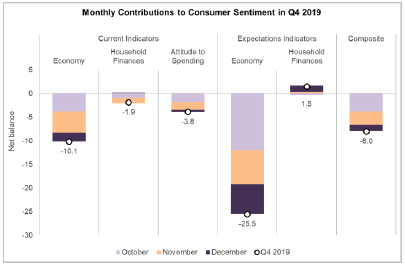
Recently published monthly consumer sentiment data enables further analysis of how consumer sentiment has changed within a quarter.
The adjacent chart shows that the -8.0 composite indicator reading for Q4, was predominantly driven by relatively weaker sentiment reported in October and November. This is consistent across the current and expectation indicators.
The overall weaknesses in expectations for the economy are likely to reflect a range of macroeconomic issues such as weaker growth and Brexit uncertainty, while ongoing resilience in the labour market and earnings growth may be supporting the more positive sentiment regarding expectations for household financial security.
Looking ahead, economic uncertainty is expected to remain elevated in 2020 through the Brexit transition phase. As such, weaknesses in business and consumer sentiment and their potential to impact on real economic activity remains a downside risk.
Economic Forecasts
The outlook for the economy over the coming year continues to be dominated by Brexit with the UK now in the transition period that will end on 31st December 2020. There remains significant uncertainty associated with whether a UK trade agreement with the EU will be reached by the end of 2020 and the potential terms of EU and non-EU trade agreements to take effect from that point. As a result, while the immediate risk of no-deal Brexit has been removed, it remains a risk to the Scottish economy over the coming year with the scale of uncertainty likely to continue impacting business and consumer sentiment.
Independent growth forecasts for Scotland expect economic growth of around 1% in 2020 and to strengthen gradually while remaining below historic levels. For example, the latest Scottish Fiscal Commission (SFC) forecast from February 2020 expects GDP growth of 1.0% in 2020 and for growth to pick up to 1.1% in 2021 and 1.2% in 2022. The Fraser of Allander Institute (FAI) forecast from December 2019 expects slightly stronger growth than the SFC of 1.3% in 2020 and 1.4% in 2021.
In the short term, the SFC and FAI forecasts expect an easing in uncertainty in 2020 as the UK moves into the Brexit transition phase, potentially supporting higher levels of consumption and business investment and assume an orderly Brexit transition at the end of 2020. The table below sets out a range of latest independent forecasts.
| Independent Scottish GDP Growth Forecasts (%)[28] | |||||
|---|---|---|---|---|---|
| 2020 | 2021 | 2022 | 2023 | 2024 | |
| Scottish Fiscal Commission | 1.0 | 1.1 | 1.2 | 1.2 | 1.2 |
| Fraser of Allander Institute | 1.3 | 1.4 | 1.4 | - | - |
| EY ITEM Club | 1.4 | 1.5 | 1.7 | 1.8 | - |
| PWC | 1.0 | - | - | - | - |
Long Term Impacts of a Free Trade Agreement with the EU – Sectoral Impacts
Introduction
This box draws on analysis published in February 2019[29] looking at the potential sectoral implications of an average Free Trade Agreement with the EU. This scenario is analogous to the UK Government’s stated aim of achieving a future trading relationship with the EU that is similar that of Canada - a CETA type deal.
Such a scenario would mean that the UK would be outside of the European Single Market and Customs Union, meaning significant barriers are likely arise over time in the trading relationship between the UK and the EU across all sectors of the economy.
Modelling approach
In order to model the industry implications of such a scenario our modelling:
- Assumes a trade deal that results in no tariffs across all products (in reality there may be some exceptions, CETA eliminates tariffs in around 98% of all tariff lines).
- Uses UK Government[30] estimates of Non-Tariff Measures that could arise under an average FTA and applies these to the sectors of the Scottish economy. Such barriers make trade more difficult by raising administrative and compliance burdens, lowering mutual recognition of standards and qualifications and disrupting cross-border supply chains.
- Assumes a reduction in future migration as a result of leaving the EU and no longer participating in freedom of movement. This is modelled as a comparison of the ONS high migration scenario (freedom of movement scenario) to the ONS principal projection scenario (restricted EU migration scenario). The difference between these two projections – approximately 8,500 per year – is what we take as the Brexit-driven reduction in migration in Scotland. An identical process was taken for rUK.
Leaving the Single Market has indirect impacts through both domestic supply chains and Scotland’s interaction with the rUK economy, as well as wider dynamic implications for investment, wages, labour availability etc. The sectoral modelling approach accounts for these complexities, and therefore provides important additional insight into the impact on sectors across the Scottish economy.
The results are long run estimates compared to a “status quo” scenario of continued EU membership for the UK as a whole, and should be interpreted as a reduction in future output rather than a contraction in current output per se. The analysis is useful in providing relative magnitudes of potential impact, however it should not be used for point estimates of impacts due to the high level of aggregation at the sectoral level.
Findings
The table below draws out the sectoral implications of a free trade agreement across three dimensions.
In the first two columns, a red indicator refers to being within the top third of the highest impact sector, whilst an orange indicator within two thirds. For the third column, a red indicator refers to the sector being at least 1.5 times more affected than the rUK sector, and an orange indicator between 1 and 1.5 times.
For example, the Chemicals, Coke & Pharmaceuticals’ sector experiences some of the highest impacts in direct sector GVA terms (red in first column), but contributes a relatively low amount of total GVA impact to the total economy-wide impact given its size (yellow in second column). Relative to rUK, while still experiencing a high negative direct impact, the direct impact on the sector is lower in Scotland than in rUK (yellow in third column). For further details, see footnote[31].
Industry impact: Goods industries are most affected as a share of industry output.
| Sector | Sector GVA Impact | Sector Contribution to Overall Economy-wide Impact | Scotland Impact relative to the Rest of UK | |
|---|---|---|---|---|
| Primary/Manufacturing Sectors | ||||
| Food & Drink | R | A | R | |
| Mining and Quarrying | R | A | A | |
| Basic Metals, Rubber & Plastic | R | A | A | |
| Electricity, Gas & Water Supply | A | A | R | |
| Agriculture, Forestry and Fishing | A | Y | R | |
| Chemicals, Coke & Pharmaceuticals | R | Y | Y | |
| Textiles, Leather, Wood & Paper | R | Y | Y | |
| Computers, Electronic & Optical | A | Y | A | |
| Machinery, Transport equipment and Furniture | A | A | Y | |
| Construction/Service Sectors | ||||
| Construction | A | A | A | |
| Professional & Scientific Services | A | R | A | |
| Transportation and storage | A | A | A | |
| Wholesale & Retail Trade | A | R | Y | |
| Administrative and support services | A | A | Y | |
| Information and communication | A | A | Y | |
| Financial and insurance activities | A | A | Y | |
| Education, Health and Social work | Y | A | A | |
| Accommodation and food services | Y | Y | Y | |
| Legend | Red (R) | Highest Negative Impact | ||
| Amber (A) | Medium Negative Impact | |||
| Yellow (Y) | Lowest Negative Impact | |||
With two-thirds of trade with the EU being in goods, these industries are the most vulnerable to trade shocks, such as changes in Non-Tariff Barriers.- Food Manufacturing, Textiles, Chemicals, Mining and Quarrying, and Metals, Rubber & Plastic are found to be the most directly impacted.
Contribution to overall impact: Service industries account for the majority of the overall economic impact.
- Service industries make up around 75% of the Scottish economy, so it is unsurprising that they contribute the most to overall declines in economy-wide GVA.
- Professional Services and Wholesale and Retail sectors contribute the most to the economy wide impact. Financial services and Construction are also significant contributors.
Impact on Scotland relative to the Rest of the UK: Agriculture, Forestry & Fishing, Food and Drink are relatively more impacted.
- Agriculture, Fishing & Forestry - reflects the concentration of activity in this sector in Scotland relative to the rUK.
- Food and Drink - reflects a large proportion of output in this sector in Scotland originates from export related activities. It is also more reliant on global exports as a share of output than it is in rest of the UK.
There remains significant uncertainty around the response of households and businesses during the Brexit transition phase, while ongoing weaknesses in global growth remain a downside risk. The future economic outlook will therefore hinge both on the broader external environment as well as the nature of the UKs future trading relationships.
Contact
Email: OCEABusiness@gov.scot
There is a problem
Thanks for your feedback